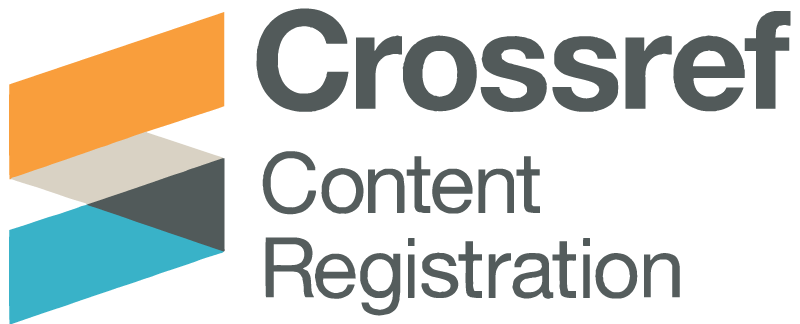تراجع عن النشر: تقدير التعبير الجيني لانزيم ADAMTS-9 في نسيج الدماغ بعد الوفاة
DOI:
https://doi.org/10.59743/aujas.v6i2.889الكلمات المفتاحية:
التصلب المتعدد، ADAMTS-9، الدماغالملخص
تم سحب هذه المقالة بناء على طلب المؤلف الثالث البروفيسور نيكولا وودروف. السبب: راسلت الأستاذة نقولا وودروف مدير التحرير وأفادت بأنها لم تر أو تقرأ مخطوطة هذه الورقة قبل تقديمها. كما أن الصور والنصوص المستخدمة في الورقة مأخوذة مباشرة من أطروحة الدكتوراه للمؤلف الأول، ومع ذلك لا يوجد ذكر لجامعة شيفيلد هالام حيث تم تسجيله كطالب دكتوراه في الوقت الذي تم فيه العمل. انتماء الأستاذة وودروف غير صحيح أيضًا ، حيث إنها حاليًا أستاذة جامعية في جامعة شيفيلد هالام. وبناء على ذلك اتصل مدير التحرير بالمؤلفين الأول والثاني ووافقوا على سحب هذه الورقة. نعتذر للقراء والمجتمع العلمي عن الإزعاج الناجم عن هذا التراجع عن النشر.المراجع
Apte, S.S. (2004). A disintegrin-like and metalloprotease (reprolysin type) with thrombospondin type 1 motifs: the ADAMTS family. The international journal of biochemistry & cell biology, 36(6), 981-985. DOI: https://doi.org/10.1016/j.biocel.2004.01.014
Barritt, A., Davies, M., Marchand, F., Hartley, R., Grist, J., Yip, P., . . . Bradbury, E. (2006). Chondroitinase ABC promotes sprouting of intact and injured spinal systems after spinal cord injury. Journal of Neuroscience, 26(42), 10856-10867. DOI: https://doi.org/10.1523/JNEUROSCI.2980-06.2006
Brown, J.M., Xia, J., Zhuang, B., Cho, K.-S., Rogers, C.J., Gama, C.I., . . . Mason, D.E. (2012). A sulfated carbohydrate epitope inhibits axon regeneration after injury. Proceedings of the National Academy of Sciences, 109(13), 4768-4773. DOI: https://doi.org/10.1073/pnas.1121318109
Chen, H., Herndon, M.E., & Lawler, J. (2000). The cell biology of thrombospondin-1. Matrix Biology, 19(7), 597-614. DOI: https://doi.org/10.1016/S0945-053X(00)00107-4
Clark, M.E., Kelner, G.S., Turbeville, L.A., Boyer, A., Arden, K.C., & Maki, R.A. (2000). ADAMTS9, a novel member of the ADAM-TS/metallospondin gene family. Genomics, 67(3), 343-350. DOI: https://doi.org/10.1006/geno.2000.6246
Cross, N., Chandrasekharan, S., Jokonya, N., Fowles, A., Hamdy, F., Buttle, D., & Eaton, C. (2005). The expression and regulation of ADAMTS‐1,‐4,‐5,‐9, and‐15, and TIMP‐3 by TGFβ1 in prostate cells: relevance to the accumulation of versican. The Prostate, 63(3), 269-275. DOI: https://doi.org/10.1002/pros.20182
Cua, R.C., Lau, L.W., Keough, M.B., Midha, R., Apte, S.S., & Yong, V.W. (2013). Overcoming neurite‐inhibitory chondroitin sulfate proteoglycans in the astrocyte matrix. Glia, 61(6), 972-984. DOI: https://doi.org/10.1002/glia.22489
Demircan, K., Hirohata, S., Nishida, K., Hatipoglu, O.F., Oohashi, T., Yonezawa, T., . . . Ninomiya, Y. (2005). ADAMTS‐9 is synergistically induced by interleukin‐1β and tumor necrosis factor α in OUMS‐27 chondrosarcoma cells and in human chondrocytes. Arthritis & Rheumatism, 52(5), 1451-1460. DOI: https://doi.org/10.1002/art.21010
Demircan, K., Yonezawa, T., Takigawa, T., Topcu, V., Erdogan, S., Ucar, F., . . . Hirohata, S. (2013). ADAMTS1, ADAMTS5, ADAMTS9 and aggrecanase-generated proteoglycan fragments are induced following spinal cord injury in mouse. Neuroscience letters, 544, 25-30. DOI: https://doi.org/10.1016/j.neulet.2013.02.064
Di Penta, A., Moreno, B., Reix, S., Fernandez-Diez, B., Villanueva, M., Errea, O., . . . Villoslada, P. (2013). Oxidative stress and proinflammatory cytokines contribute to demyelination and axonal damage in a cerebellar culture model of neuroinflammation. PLoS one, 8(2), e54722. DOI: https://doi.org/10.1371/journal.pone.0054722
Faulkner, J.R., Herrmann, J.E., Woo, M.J., Tansey, K.E., Doan, N.B., & Sofroniew, M.V. (2004). Reactive astrocytes protect tissue and preserve function after spinal cord injury. Journal of Neuroscience, 24(9), 2143-2155. DOI: https://doi.org/10.1523/JNEUROSCI.3547-03.2004
Goddard, D.R., Bunning, R.A., & Woodroofe, M.N. (2001). Astrocyte and endothelial cell expression of ADAM 17 (TACE) in adult human CNS. Glia, 34(4), 267-271. DOI: https://doi.org/10.1002/glia.1060
Gottschall, P.E., & Howell, M.D. (2015). ADAMTS expression and function in central nervous system injury and disorders. Matrix Biology, 44, 70-76. DOI: https://doi.org/10.1016/j.matbio.2015.01.014
Haddock, G., Cross, A., Plumb, J., Surr, J., Buttle, D., Bunning, R.A., & Woodroofe, M. (2006a). Expression of ADAMTS-1,-4,-5 and TIMP-3 in normal and multiple sclerosis CNS white matter. Multiple Sclerosis Journal, 12(4), 386-396. DOI: https://doi.org/10.1191/135248506ms1300oa
Hayashi, K., Kadomatsu, K., & Muramatsu, T. (2001). Requirement of chondroitin sulfate/dermatan sulfate recognition in midkine-dependent migration of macrophages. Glycoconjugate journal, 18(5), 401-406. DOI: https://doi.org/10.1023/A:1014864131288
Hoffmann, C.J., Harms, U., Rex, A., Szulzewsky, F., Wolf, S.A., Grittner, U., . . . Dirnagl, U. (2015). Vascular signal transducer and activator of transcription-3 promotes angiogenesis and neuroplasticity long-term after stroke. Circulation, 131(20), 1772-1782. DOI: https://doi.org/10.1161/CIRCULATIONAHA.114.013003
Kodaira, Y., Nair, S.K., Wrenshall, L.E., Gilboa, E., & Platt, J.L. (2000). Phenotypic and functional maturation of dendritic cells mediated by heparan sulfate. The Journal of Immunology, 165(3), 1599-1604. DOI: https://doi.org/10.4049/jimmunol.165.3.1599
Kumar, S., Rao, N., & Ge, R. (2012). Emerging roles of ADAMTSs in angiogenesis and cancer. Cancers, 4(4), 1252-1299. DOI: https://doi.org/10.3390/cancers4041252
Kuno, K., Okada, Y., Kawashima, H., Nakamura, H., Miyasaka, M., Ohno, H., & Matsushima, K. (2000). ADAMTS‐1 cleaves a cartilage proteoglycan, aggrecan. FEBS letters, 478(3), 241-245. DOI: https://doi.org/10.1016/S0014-5793(00)01854-8
Lau, L.W., Cua, R., Keough, M.B., Haylock-Jacobs, S., & Yong, V.W. (2013). Pathophysiology of the brain extracellular matrix: a new target for remyelination. Nature Reviews Neuroscience, 14(10), 722. DOI: https://doi.org/10.1038/nrn3550
Lemarchant, S., Pruvost, M., Montaner, J., Emery, E., Vivien, D., Kanninen, K., & Koistinaho, J. (2013). ADAMTS proteoglycanases in the physiological and pathological central nervous system. Journal of neuroinflammation, 10(1), 899. DOI: https://doi.org/10.1186/1742-2094-10-133
Lemons, M.L., Sandy, J.D., Anderson, D.K., & Howland, D.R. (2001). Intact aggrecan and fragments generated by both aggrecanse and metalloproteinase-like activities are present in the developing and adult rat spinal cord and their relative abundance is altered by injury. Journal of Neuroscience, 21(13), 4772-4781. DOI: https://doi.org/10.1523/JNEUROSCI.21-13-04772.2001
Luan, Y., Kong, L., Howell, D.R., Ilalov, K., Fajardo, M., Bai, X.-H., . . . Liu, C.-J. (2008). Inhibition of ADAMTS-7 and ADAMTS-12 degradation of cartilage oligomeric matrix protein by alpha-2-macroglobulin. Osteoarthritis and cartilage, 16(11), 1413-1420. DOI: https://doi.org/10.1016/j.joca.2008.03.017
Matthews, R.T., Gary, S.C., Zerillo, C., Pratta, M., Solomon, K., Arner, E.C., & Hockfield, S. (2000). Brain-enriched hyaluronan binding (BEHAB)/brevican cleavage in a glioma cell line is mediated by a disintegrin and metalloproteinase with thrombospondin motifs (ADAMTS) family member. Journal of Biological Chemistry, 275(30), 22695-22703. DOI: https://doi.org/10.1074/jbc.M909764199
Miguel, R.F., Pollak, A., & Lubec, G. (2005). Metalloproteinase ADAMTS-1 but not ADAMTS-5 is manifold overexpressed in neurodegenerative disorders as Down syndrome, Alzheimer's and Pick's disease. Molecular brain research, 133(1), 1-5. DOI: https://doi.org/10.1016/j.molbrainres.2004.09.008
Nakamura, H., Fujii, Y., Inoki, I., Sugimoto, K., Tanzawa, K., Matsuki, H., . . . Okada, Y. (2000). Brevican is degraded by matrix metalloproteinases and aggrecanase-1 (ADAMTS4) at different sites. Journal of Biological Chemistry, 275(49), 38885-38890. DOI: https://doi.org/10.1074/jbc.M003875200
Nandini, C.D., & Sugahara, K. (2006). Role of the sulfation pattern of chondroitin sulfate in its biological activities and in the binding of growth factors. Advances in pharmacology, 53, 253-279. DOI: https://doi.org/10.1016/S1054-3589(05)53012-6
Reid, M.J., Cross, A.K., Haddock, G., Allan, S.M., Stock, C.J., Woodroofe, M.N., . . . Bunning, R.A. (2009). ADAMTS-9 expression is up-regulated following transient middle cerebral artery occlusion (tMCAo) in the rat. Neuroscience letters, 452(3), 252-257. DOI: https://doi.org/10.1016/j.neulet.2009.01.058
Rodrıguez-Manzaneque, J.C., Westling, J., Thai, S.N.-M., Luque, A., Knauper, V., Murphy, G., . . . Iruela-Arispe, M.L. (2002). ADAMTS1 cleaves aggrecan at multiple sites and is differentially inhibited by metalloproteinase inhibitors. Biochemical and biophysical research communications, 293(1), 501-508. DOI: https://doi.org/10.1016/S0006-291X(02)00254-1
Rolls, A., Cahalon, L., Bakalash, S., Avidan, H., Lider, O., & Schwartz, M. (2006). A sulfated disaccharide derived from chondroitin sulfate proteoglycan protects against inflammation-associated neurodegeneration. The FASEB journal, 20(3), 547-549. DOI: https://doi.org/10.1096/fj.05-4540fje
Rosenberg, G., Estrada, E., & Dencoff, J. (1998). Matrix metalloproteinases and TIMPs are associated with blood-brain barrier opening after reperfusion in rat brain. Stroke, 29, 2189-2194. DOI: https://doi.org/10.1161/01.STR.29.10.2189
Sanders, V., Conrad, A.J., & Tourtellotte, W.W. (1993). On classification of post-mortem multiple sclerosis plaques for neuroscientists. Journal of neuroimmunology, 46(1-2), 207-216. DOI: https://doi.org/10.1016/0165-5728(93)90251-S
Sandy, J.D., Westling, J., Kenagy, R.D., Iruela-Arispe, M.L., Verscharen, C., Rodriguez-Mazaneque, J.C., . . . Wight, T.N. (2001). Versican V1 proteolysis in human aorta in vivo occurs at the Glu441-Ala442 bond, a site that is cleaved by recombinant ADAMTS-1 and ADAMTS-4. Journal of Biological Chemistry, 276(16), 13372-13378. DOI: https://doi.org/10.1074/jbc.M009737200
Shen, Y., Tenney, A.P., Busch, S.A., Horn, K.P., Cuascut, F.X., Liu, K., . . . Flanagan, J.G. (2009). PTPσ is a receptor for chondroitin sulfate proteoglycan, an inhibitor of neural regeneration. Science, 326(5952), 592-596. DOI: https://doi.org/10.1126/science.1178310
Sobel, R.A., & Ahmed, A.S. (2001). White matter extracellular matrix chondroitin sulfate/dermatan sulfate proteoglycans in multiple sclerosis. Journal of Neuropathology & Experimental Neurology, 60(12), 1198-1207. DOI: https://doi.org/10.1093/jnen/60.12.1198
Somerville, R.P., Longpre, J.-M., Jungers, K.A., Engle, J.M., Ross, M., Evanko, S., . . . Apte, S.S. (2003). Characterization of ADAMTS-9 and ADAMTS-20 as a distinct ADAMTS subfamily related to Caenorhabditis elegans GON-1. Journal of Biological Chemistry, 278(11), 9503-9513. DOI: https://doi.org/10.1074/jbc.M211009200
Tauchi, R., Imagama, S., Natori, T., Ohgomori, T., Muramoto, A., Shinjo, R., . . . Kadomatsu, K. (2012). The endogenous proteoglycan-degrading enzyme ADAMTS-4 promotes functional recovery after spinal cord injury. Journal of neuroinflammation, 9(1), 53. DOI: https://doi.org/10.1186/1742-2094-9-53
Tian, Y., Zhang, P., Xiao, X., Zhang, J., Zhao, J., Kang, Q., . . . Liu, Y. (2007). The quantification of ADAMTS expression in an animal model of cerebral ischemia using real‐time PCR. Acta anaesthesiologica scandinavica, 51(2), 158-164. DOI: https://doi.org/10.1111/j.1399-6576.2006.01161.x
Tortorella, M., Burn, T., Pratta, M., Abbaszade, I., Hollis, J., Liu, R., . . . Wynn, R. (1999). Purification and cloning of aggrecanase-1: a member of the ADAMTS family of proteins. Science, 284(5420), 1664-1666. DOI: https://doi.org/10.1126/science.284.5420.1664
Tortorella, M., Malfait, A.-M., Deccico, C., & Arner, E. (2001). The role of ADAM-TS4 (aggrecanase-1) and ADAM-TS5 (aggrecanase-2) in a model of cartilage degradation. Osteoarthritis and Cartilage, 9(6), 539-552. DOI: https://doi.org/10.1053/joca.2001.0427
Van der Valk, P., & De Groot, C. (2000). Staging of multiple sclerosis (MS) lesions: pathology of the time frame of MS. Neuropathology and applied neurobiology, 26(1), 2-10. DOI: https://doi.org/10.1046/j.1365-2990.2000.00217.x
Westling, J., Gottschall, P.E., Thompson, V.P., Cockburn, A., Perides, G., Zimmermann, D.R., & Sandy, J.D. (2004). ADAMTS4 (aggrecanase-1) cleaves human brain versican V2 at Glu405-Gln406 to generate glial hyaluronate binding protein. Biochemical Journal, 377(3), 787-795. DOI: https://doi.org/10.1042/bj20030896
Yaykasli, K.O., Oohashi, T., Hirohata, S., Hatipoglu, O.F., Inagawa, K., Demircan, K., & Ninomiya, Y. (2009). ADAMTS9 activation by interleukin 1β via NFATc1 in OUMS-27 chondrosarcoma cells and in human chondrocytes. Molecular and cellular biochemistry, 323(1-2), 69-79. DOI: https://doi.org/10.1007/s11010-008-9965-4
Zeng, W., Corcoran, C., Collins-Racie, L.A., LaVallie, E.R., Morris, E.A., & Flannery, C.R. (2006). Glycosaminoglycan-binding properties and aggrecanase activities of truncated ADAMTSs: comparative analyses with ADAMTS-5,-9,-16 and-18. Biochimica et Biophysica Acta (BBA)-General Subjects, 1760(3), 517-524. DOI: https://doi.org/10.1016/j.bbagen.2006.01.013
التنزيلات
منشور
كيفية الاقتباس
إصدار
القسم
الرخصة
الحقوق الفكرية (c) 2023 السعداوي أبوعنيزة، إسماعيل معمر مخزوم الحويج، نيكولا وودروف، أشلي ادوارد رو سوسى

هذا العمل مرخص بموجب Creative Commons Attribution 4.0 International License.
تتعلق الحقوق بنشر وتوزيع البحوث المنشورة في مجلة الجامعة الأسمرية، حيث توضح للمؤلفين الذين نشروا مقالاتهم في مجلة الجامعة الأسمرية، كيفية استخدام أو توزيع مقالاتهم، والاحتفاظ بجميع حقوقهم في المصنفات المنشورة، مثل (على سبيل المثال لا الحصر) الحقوق التالية:
- حقوق الطبع والنشر وحقوق الملكية الأخرى المتعلقة بالمقال المقدم، مثل حقوق براءات الاختراع.
- استخدام البحث المنشور في مجلة الجامعة الأسمرية في الأعمال المستقبلية الخاصة بالمؤلفين، بما في ذلك المحاضرات والكتب، والحق في إعادة إنتاج المقالات لأغراضهم الخاصة، والحق في الأرشفة الذاتية لمقالاتهم.
- الحق في الدخول في مقال منفصل، أو للتوزيع غير الحصري لمقالاتهم مع الإقرار بنشره الأولي في مجلة الجامعة الأسمرية.
الحقوق الفكرية: وفق الرخصة الدولية للأعمال الإبداعية المشاعة، النسخة 4.0.
بيان الخصوصية: سيتم استخدام الأسماء وعناوين البريد الإلكتروني التي تم إدخالها في موقع مجلة الجامعة الأسمرية للأغراض المذكورة فقط والتي استخدمت من أجلها.










